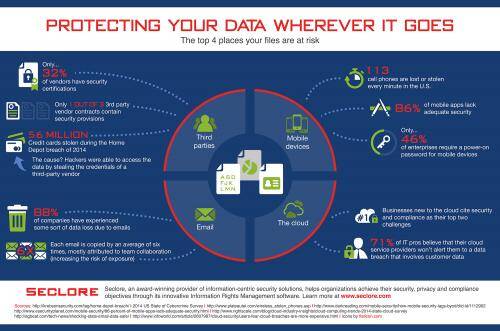Many of today’s businesses have moved on from the large metal filing cabinets of yore, replacing them with digital files, the cloud and mobile devices. These technologies have had a huge improvement on the organization, management and access of customer and company data.
Unfortunately, security has been a major recurring issue as these technologies continue to be adopted, with data breaches happening across small businesses and corporations (Home Depot and Sony ring a bell?).
Many of today’s businesses have moved on from the large metal filing cabinets of yore, replacing them with digital files, the cloud and mobile devices. These technologies have had a huge improvement on the organization, management and access of customer and company data.
Unfortunately, security has been a major recurring issue as these technologies continue to be adopted, with data breaches happening across small businesses and corporations (Home Depot and Sony ring a bell?).
In today’s world, the top four places your data is at risk is the cloud, email, third parties and mobile devices according to a new study by information security company Seclore.
For instance, did you know that only 33% of third party vendor contracts contains security provisions? Lack of security provisions was most likely the cause of the Home Depot data breach of 2014, which comprised over 56 million credit cards – because hackers were able to steal the credentials of a third party vendor who had access to Home Depot’s backend. Fortunately, security compliances are fairly simple to create and enforce with online software.
Now let’s look at Email: 88% of companies have experienced some sort of data loss due to emails, and each email is copied an average of six times. That means emails that contain confidential or sensitive information are six times more likely to be exposed than normal, which is not good news in the event of a data breach. Encryption technologies like PGP, stronger password policies and email backup are a great way to fix this problem.
With smartphones and BYOD (Bring your own device) on the rise, mobile devices are also increasing in security vulnerability. In the U.S. alone, 113 cell phones are lost or stolen each minute! But more alarming is that only half of companies require a power-on password for mobile devices. A great way to fix this issue is by improving mobile device use policies within the company – require your employees to use stronger passwords and multiple forms of device authentication.
Finally, the cloud can be a major data security concern because the technology is still fairly new for the average business. Businesses new to the cloud cite security and compliance as their top two challenges. Online security software is a great and affordable way for businesses to get started with the cloud and ensure that their data is secure.
Take a look at Seclore’s infographic below for more statistics. What software and services are you using to protect your company and customer data?
